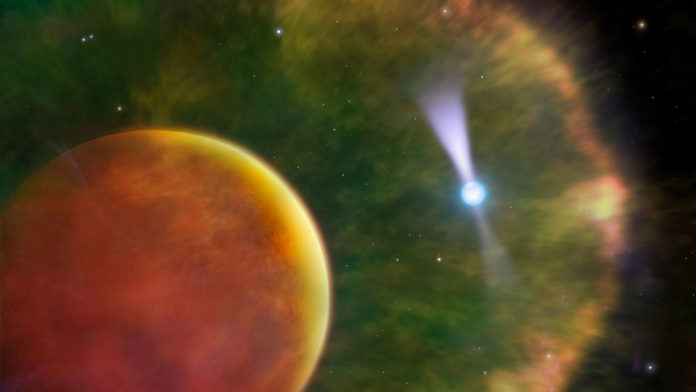Off in space, 6,500 light years away from Earth, are the remnants of a massive star that exploded as a supernova. Its core compacted down to a spinning neutron star, one of the most massive ones ever observed, sending beams of radio waves out from its poles and across the cosmos like a lighthouse as it spins. Also known as a pulsar, this massive neutron star is sitting right on the edge of collapsing into a black hole.
But the pulsar is not alone, and that’s one of the features that makes it fascinating. It is one partner in a binary system, paired with a brown dwarf, only 20 kilometers apart and both orbiting around a common centre of mass. The brown dwarf is cool and lightweight, and occupies a domain somewhere between a star and a massive planet.
The pulsar is named PSR B1957+20, but it’s also known as a black widow pulsar. Its powerful radiation blasts particles at its partner, stripping away layers of matter from its companion in the form of ionized and magnetized gas called plasma. This continual erosion will eventually consume the brown dwarf completely.
But it’s also this stream of plasma that both eclipses and magnifies signals from the pulsar. Canadian researchers used this phenomenon to make one of the highest resolution observations in the history of astronomy.
The study, authored by researchers at the University of Toronto’s Dunlap Institute for Astronomy & Astrophysics, the Canadian Institute for Theoretical Astrophysics, and the Perimeter Institute, was published in Nature.
Astronomers have long known about the lensing power of ionized gas, as most pulsars appear to scintillate when interstellar matter transiently boosts their observed brightness. This allows researchers to zoom in on the pulsar, but the effect is usually very small.
Surprisingly, astronomers have also known about this binary pair for over 30 years, and the discovery was made using a telescope operating since the 1960s. Since then, however, big advances have been made in computing and data-recording power. This enables researchers to study pulsars at ever-shortening timescales, and over broader ranges of radio frequencies.
This particular binary system is interesting because the two partners are so close together. At 20 kilometres apart, they would almost fit inside the sun. The proximity of the plasma coming off the brown dwarf means that the lensing effect is exceptionally strong.
“The gas is acting like a magnifying glass right in front of the pulsar,” says lead author Robert Main, PhD student of astronomy and astrophysics at the University of Toronto. “We are essentially looking at the pulsar through a naturally occurring magnifier, which periodically allows us to see the two regions separately.”
The authors report that signals right before and after the plasma stream eclipses the pulsar can be boosted up to 70-80 times brighter than the average at selected radio frequencies.
The effect is a bit like how the ripples of a swimming pool distort sunlight, resulting in amplified patterns of observed light known as caustics. The plasma bends the radio signals from the pulsar, resulting in brighter and more focussed observations.

This allowed the team to measure the physical offset of radio emissions originating from different regions of the magnetosphere, a magnetized atmosphere that extends about 100 kilometres from the pulsar’s surface. Given that the pulsar is about 100,000,000,000,000,000 kilometres away from Earth, that’s like measuring the width of a hair on Mars. Telescopes don’t even come close to this resolution.
Some of the signatures the authors observed look similar to fast radio bursts, which are signals of unknown origin coming from other galaxies. The authors speculate that these might be signals from pulsars lensed by interstellar matter in their home galaxies.
Being able to zoom in on pulsars in this way opens big opportunities for understanding the visible universe. Unlike black holes, pulsars are still visible. That makes them some of the most massive objects in the visible universe, and studying them allows us to peer into the most extreme ends of what can be seen.








































